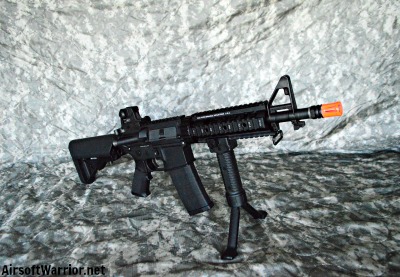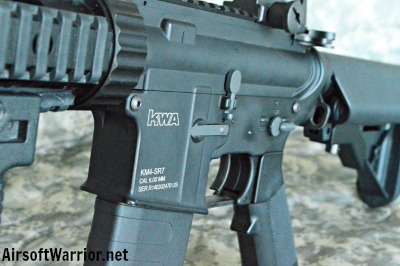
(affiliate links included)
I bought my KWA SR7 last September from AirRattle.com for $270. After using it for a full year of airsofting, and obtaining a good amount of experience with it, I want to share my thoughts on this weapon.
The Way I Run It:
Before we hop into my thoughts, I want to explain how I run my SR7 so you can get an idea of what the performance is like.
- I use a 9.6v NiMH battery,which gives me about 16 RPS and a fair trigger response.
- I run KWA K120 mid cap magazines
for guaranteed feeding and quality construction.
- I’ve mounted a Sightmark Reflex Red Dot
for faster target acquisition in dark CQB environments.
- I have a few ladder rail covers
installed to keep my hands off the bare metal of the RIS. I have used a grip pod
with the SR7 and found it to be a useful tool for setting down the weapon in between games, and for use as a hand rest (although I will often just use the mag well).
Now, onto my thoughts about the SR7.
Performance:
KWA is known for having great performance right out of the box. The manufacturer uses a 6.05mm Tight Bore Barrel (TBB) for better accuracy, 2nd Generation (2g) hop up system for better overall range and accuracy, and the 2nd Generation Extreme (2gx) gearbox with proprietary parts for enhanced reliability and power.
I’ve found that this system works like it was designed. My SR7 gets 355 FPS (which has settled into the 335 range over time) with 0.20g BBs and has an effective range (can hit a man sized target) of 125 feet on semi auto. Though, most of the time, I only use the KWA at CQB fields where the maximum range is 75 feet or so.
My SR7 has performed very admirably over the course of the past year. I’ve had no problem making a multitude of mid range kills, and rocking it outdoors.

Things I Like:
There is a lot to like about the SR7. Here are some of the top things I enjoy about it:
Crane Stock: The fins that hold the stock plate on are solid and should last a long time. The battery compartment inside is intelligently designed with space for a nunchuck NiMH or brick style LiPo battery. The fuse is exposed and fitted into a special compartment in the stock, so it is easy to check and replace (although I’ve never needed to yet).
Free Float RIS: The rail is easy to use, has zero wobble, and fits everything I need. It was a big upgrade over the two piece, wobbly rail on my JG M4 RIS.
Sound: The SR7 makes an awesome sound! Its powerful “clunk” (for lack of a better word) scares the tar out of those high pitched, whiny guns you find elsewhere! 😉
Things I Haven’t Liked:
There have been a few things that I haven’t liked (and may never come to like) while using the SR7. Here they are:
Proprietary Parts: KWA is known for using proprietary parts in their guns. This is designed to make the AEG perform better overall, but it can make finding replacement parts difficult. I personally haven’t needed to break open my SR7 since everything is working fine, but it is an aspect that I would like to point out for those who plan to upgrade later.
Hop Up Movement: When I close the fake bolt after adjusting the hop up, it tends to shift the setting. This is a bit annoying, and requires some work to prevent. A rotary hop up would solve this issue, but since the 2-piece hop up is somewhat proprietary, I haven’t tried to replace it.
Triangle Front Sight: I like the look and function of flip up sights better than the traditional triangle sight. They’re less intrusive when using a red dot and tend to look better.
Quirks:
My SR7 has had a few quirks and hiccups since I’ve owned it. Nothing major, but worth noting.
- The range of the SR7 seems to significantly decrease when the battery power is low. This may be due to a case of double feeding and some issues with the bucking (which I may need to replace soon). Although this is a bit annoying, at least I always know when the battery is low! 🙂
- The selector switch on the side of the gun sometimes moves and cause the gun to switch fire modes. This is a somewhat common issue with airsoft guns and is easy to fix in-game. A stiffer selector switch on upcoming models would be appreciated.
- One of the issues that all Version 2 gearboxes have is what I call semi auto lock up. The cut off lever decides to cause issues occasionally and make the trigger “lock”, keeping the gun from firing. I’ve only had this issue once or twice in the past year. All you have to do is switch the gun to full auto, fire a couple of rounds, and you should be back in business. This issue can’t be permanently fixed without removing the cut off lever and installing a MOSFET, but it isn’t a big enough issue to make me break down and get one yet.
- The SR7 doesn’t like Elite Force 140 round Mid Caps (AirRattle sent some free with the gun). I have found that I can insert the Elite Force mag and the KWA will fling the BBs about 3 feet out the barrel. After ejecting the SAME MAGAZINE and putting it back in, the SR7 works normally! Still scratching my head on this one….
Overall the SR7 is still doing its job of sending enemies to respawn after a year of use. I look forward to using it in the year to come!
If you have any questions about the SR7, or airsoft in general, leave a comment! If you liked this post, be sure to use the share buttons to let all your friends know that you’re an Airsoft Warrior! To learn more about the KWA SR7, check out my internal and external reviews.




















